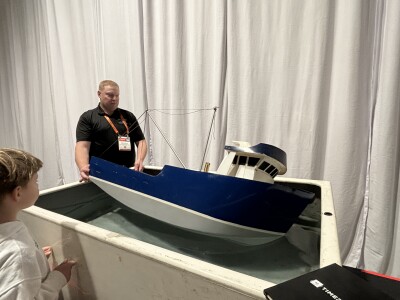Pair of aces
Purse boats are the workhorses of Chesapeake’s menhaden fleet
By Larry Chowning
Omega Shipyard in Moss Point, Miss., delivered two new 41' 6" x 12' aluminum menhaden purse boats to the Reedville, Va., Omega Protein plant in February. They will be fishing in Chesapeake Bay and offshore.
Omega Protein, the largest harvester of menhaden in the world, fishes 27 steamers — some as long as 196 feet. Seven work the Chesapeake and Atlantic out of Reedville; seven fish for the Moss Point plant; and 13 tie up at the Abbeville, La., fish plant. Each steamer has two purse boats and every year Omega Shipyard builds two sets, or four new boats.
Working in pairs, purse boats encircle a school of menhaden, each dumping half the net. When they come together and the net is closed, power blocks on each boat haul in the net, bringing the menhaden to the surface, where they can be pumped into the steamer’s hold.
The boats are built at the Moss Point shipyard for all three plants. Though once in Virginia they are modified. Harvey Hamm, Omega’s vessel manager in Reedville, says, “The Moss Point yard builds the boats to run, and we modify the boats to go fishing.”
The hulls are built upside down with 10 watertight aluminum bulkheads that are cut to give the bottom a V-shape, which flattens out as it goes aft. Running through the bulkheads from stem to stern are two strongbacks, one on each side.
After the yard’s crew welds the longitudinal stringers, keel, skeg and bottom plating to the hull’s framework, it’s flipped over and the sides, decking and engine installed. All the hull plating is 3/8 inch.
The early purse boats were built without keels and skegs, but that started to change after the Gulf of Mexico fishery went to a slide system. Instead of hanging from davits on the side of the boat, purse boats are hauled up on a platform built into the steamer’s stern. That requires a keel and skeg combination for the boats to sit level on the back of the steamer and for sliding down into the water.
The slide system is considered a safer operation than davits, and the boats can get to the fish quicker. In 2013, Omega added two new slide system steamers, the Rappahannock and Fleeton, to its Chesapeake Bay fleet. “Time is money,” says Hamm, “and the slide system eliminates a lot of moving parts, which helps speed up the fishing process and makes it safer for the fishermen.”
Though Omega eventually plans “to have all our boats using the slide system,” says Hamm; it will be a number of years before the fleet shifts completely to hauling and launching purse boats off the stern. In part that’s because some of the steamers don’t lend themselves to that type of operation. That includes a couple of World War II freight and supply boats. They were converted in the 1970s into menhaden fish steamers and have proven to be solid workhorses. “I will tell you this, those F/S boats have been a good platform for us, and we have worked them for over 40 years,” says Robert Oder, marine superintendent of the Reedville machine shop.
But as Hamm notes, “It’s not practical to put a slide rig on the F/S boats. It could be done but there would have to be... » Read the full article in our AUGUST issue.








